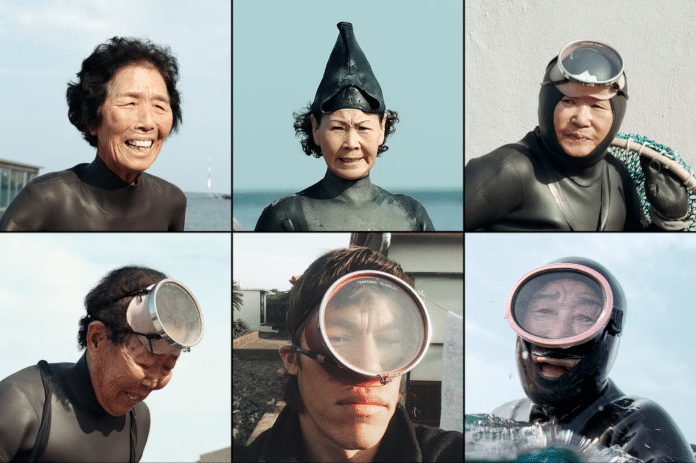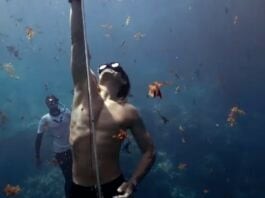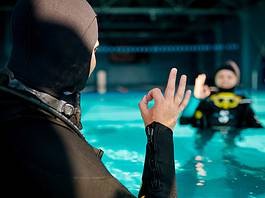Can you imagine a seafood-harvesting workforce numbering in the thousands, composed entirely of women, who gather their catch strictly by freediving with simple tools? This institution has indeed existed for centuries on Jeju Island, an island off South Korea comparable in size to Maui, and I was fortunate to catch a glimpse of it firsthand. These are some of my photos from my chance meeting, along with excerpts from my research about the haenyeo. I invite you to browse my essay and learn about one of the oldest roots of freediving…
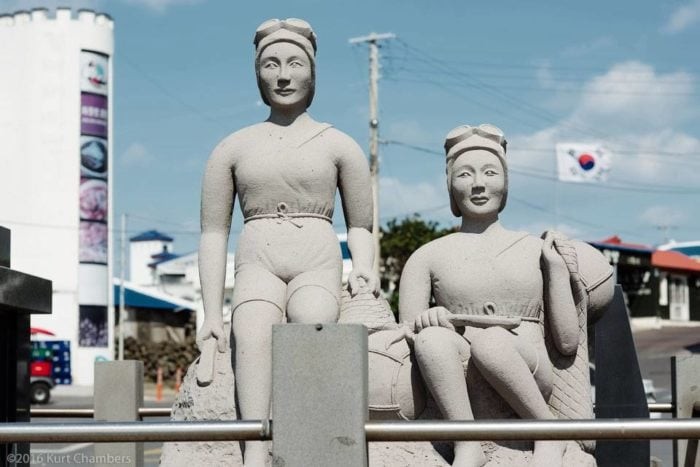
The temperate waters of Korea have a long, native history of breath-hold diving. With seafood being tremendously valuable both commercially and culturally to Koreans, they took to the seas long ago to manually collect varieties that are not easily gathered with conventional fishing methods (much the same as with opihi and tako in Hawai‘i).
Another of their original motivations may have been to gather the treasured iridescent pearls found in their abalone, offered as tributes to the king. Eventually there were royal expectations of these delicacies: an 18th-century document recorded that greedy officials went so far as to flog the women, and even their parents or husbands, when they failed to pay steep taxes in dried abalone, a prized delicacy among Korea’s elite, forcing these women to dive in cold water even when pregnant.
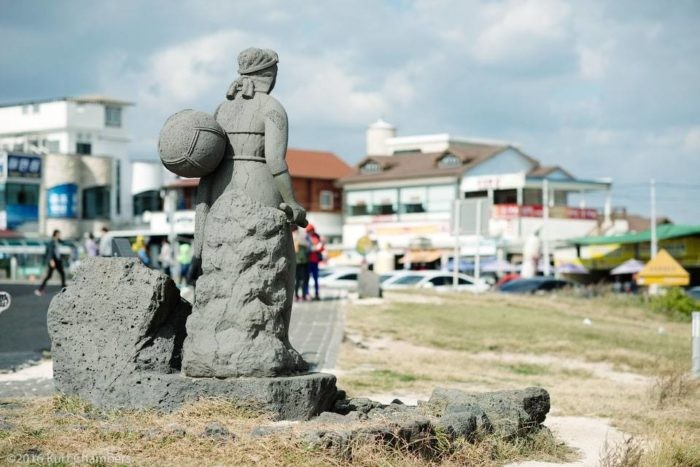
Originally, diving was an exclusively male tradition, but by the 18th century female divers outnumbered the male, for a variety of possible reasons. In the 17th century, many men died at sea while rowing warships or falling victim to deep-sea fishing accidents, leaving the women to take up the post in order to survive. Further, new laws imposed a steep tax on this work for men, which the women were not subject to, making the trade far more profitable for the female partner. Another explanation is along the lines of evolution, that women on average have more subcutaneous fat and a higher shivering threshold than men, allowing them an advantage diving in the frigid waters of Korea before the advent of rubber wetsuits only relatively recently in the 1970s. Whichever the reason may be, this rise in the female occupation of the most valuable trade in Jeju resulted in a rare example of a female-dominated society, where haenyeo replaced their husbands as the primary breadwinners and sat at the head of the household.
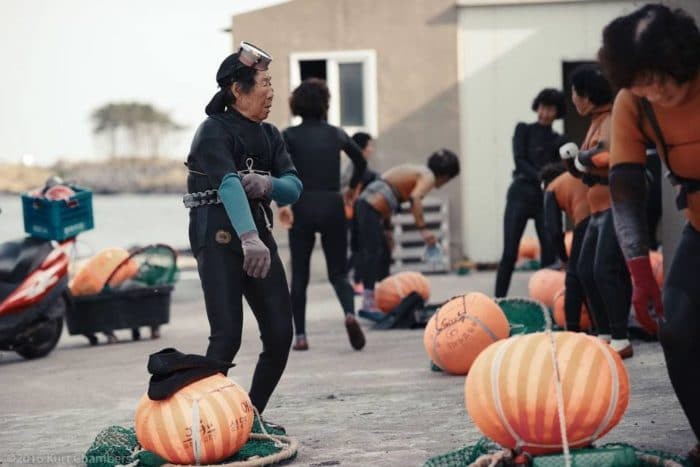
On a cool but clear morning I met my Korean diving penpal, Taihoon Lee, who arranged for me to join a haenyeo troupe during a morning of work. This came together at the last minute, as foreigners are not normally welcomed to swim with or photograph the haenyeo.
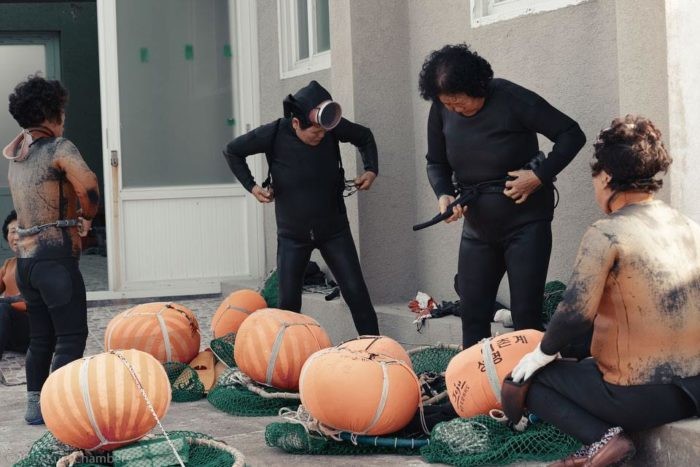
I had envisioned a dive culture-exchange session, in which the elderly women would be fascinated by my long-blade fins and low-volume mask, but they only looked at me with nonchalance rather than curiosity. In fact, I felt about as welcome as uninvited paparazzi as I shot photos of the women preparing their gear at their bulteok, a building serving as their headquarters.
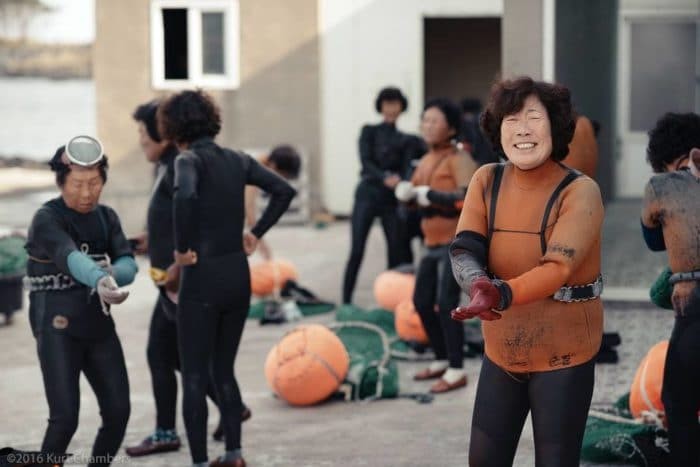
The sense of camaraderie was palpable as the women assisted each other into their wetsuits, probably over banter about their husbands and body aches. Most of these weathered women had probably been diving together for decades.
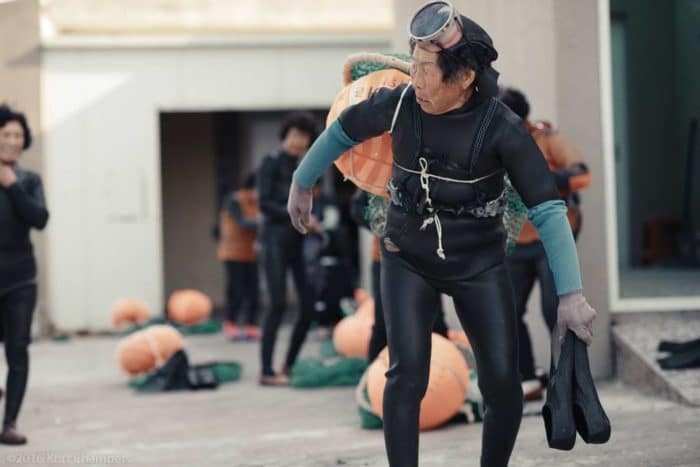
As of 2014, 98% of remaining haenyeo were over the age of 50. The oldest haenyeo I met was 94 and I heard some women have practiced since childhood for over 70 years.
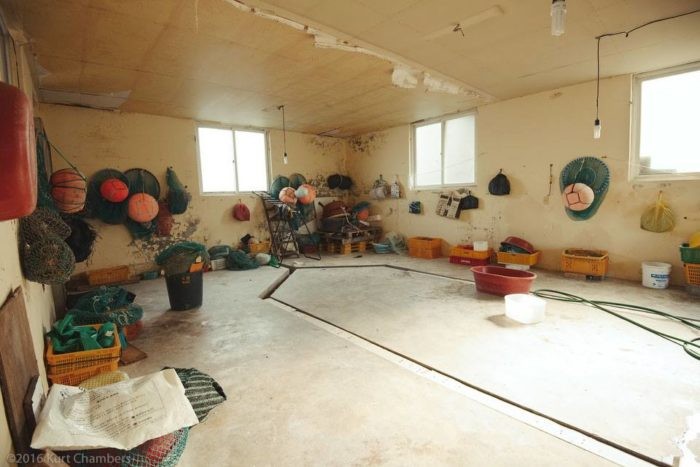
The bulteok is a place where the haenyeo warm themselves or change clothes when they have finished their diving work. Along with the importance as a physical space, it also served as an institutionally important place to build relationships within the haenyeo community. They would exchange information and also decide on an issue by putting it up for vote here.
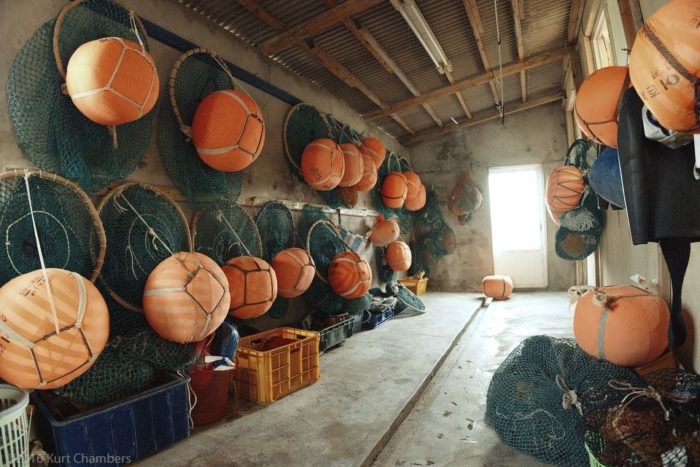
The Korean government recognized the importance of the haenyeo and fortunately celebrates their existence and history as one of Korea’s most valued treasures. The government now subsidizes their gear, bathhouses, and medical coverage, and grants them exclusive rights to sell fresh seafood in Jeju.
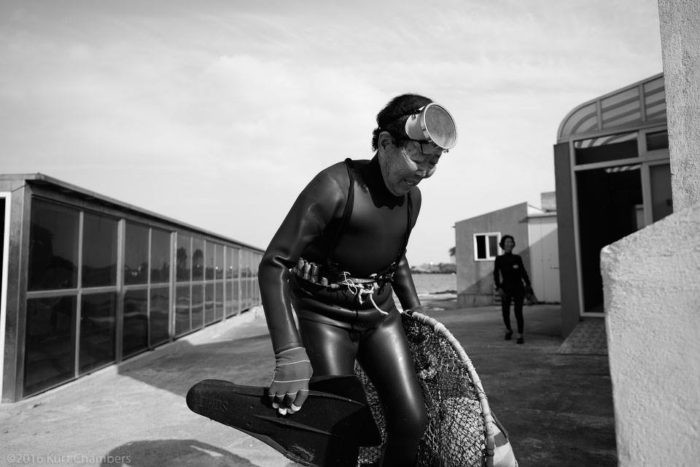
The haenyeo were divided into different categories depending on their age, aptitude for diving and their character. They were categorized as superior class haenyeo, middle class and low class. They had a strict order of hierarchy as could be seen in designating the places to sit according to status in the bulteok. Within the haenyeo community there is a tradition of following directions according to seniority; the actions and words of the elderly became exemplary models to abide by.
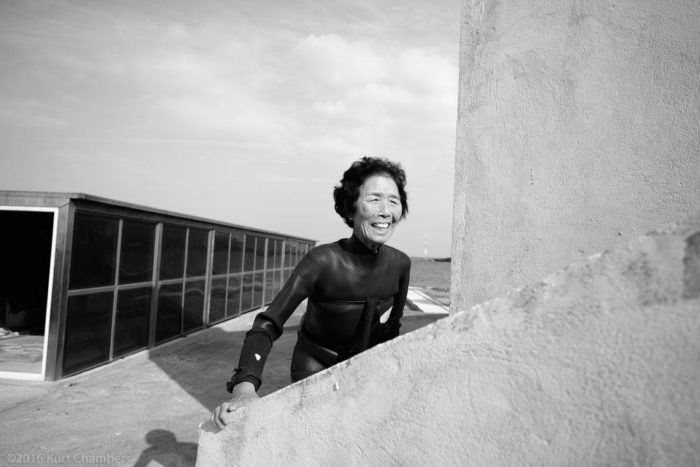
This characteristic of unity and respect among the haenyeo was especially visible when many protested the colonial invasion of Korea by the Japanese in 1910, providing inspiration and serving as a symbol of female independence and strength in Korea.
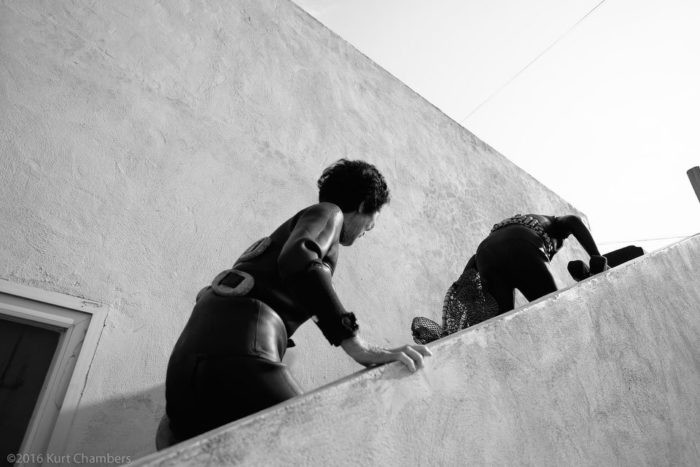
From the beginning of the 1880s, with overfishing on the part of Japanese boats, there was a danger of the abalone being exhausted. Therefore, the haenyeo began venturing outside of Jeju in search of more sources. They left not only to other shores of Korea, but also to Japan, China and Russia. Diving away from home was a career possible due to the capability of transporting these fisheries in dried form, and the high value of them. The haenyeo were well aware of their labor value as an economic asset.
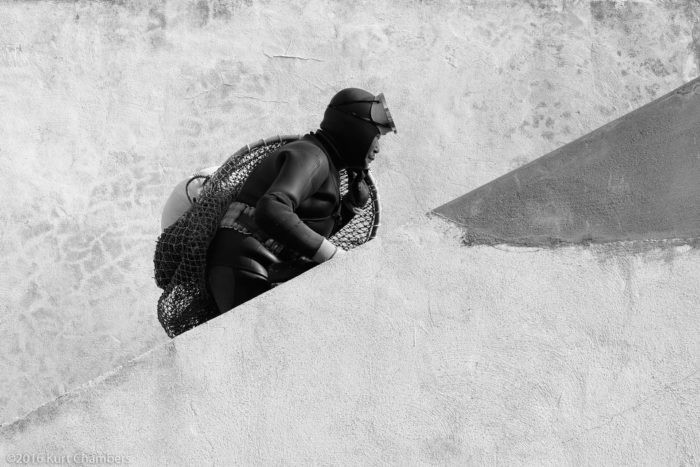
The lives of Jeju haenyeo have always been difficult due to the hard labor imposed on them in unfavorable natural conditions as well as a burdensome tax levied on them. However, they were able to overcome the struggle to protect their occupation as well as the dignity of human life. The resistance against the brutal Japanese imperialism was particularly fruitful. Historians now regard their effort as not simply a fight to reclaim the right to live against the economic exploitation of Japanese imperialism, but also an important part of the national resistance of Korean people to restore independence and sovereignty by ending the repressive colonial rule.
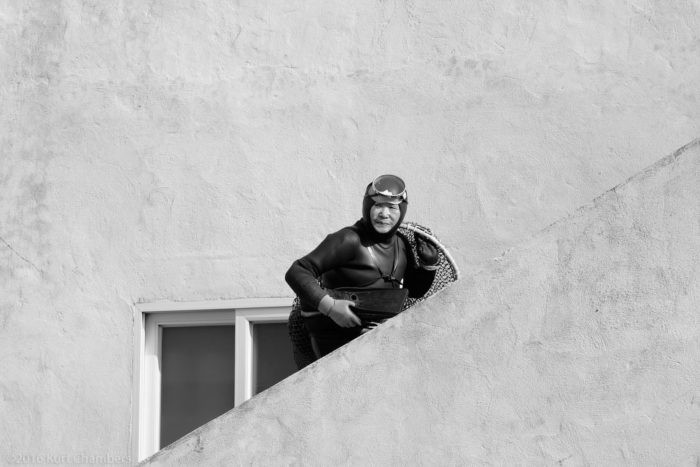
Within the songs that the haenyeo sing, there are elements of tragedy and world weariness commonly portrayed. In such songs they describe themselves as having a tragic view of life and locate the source of that tragedy in their own ‘destiny’. They identify as having the same lot as their mothers; as they are both women (and mothers usually haenyeo as well), mothers are viewed as being in the same difficult class of existence while at the same time a subject for complaining about their grievances.
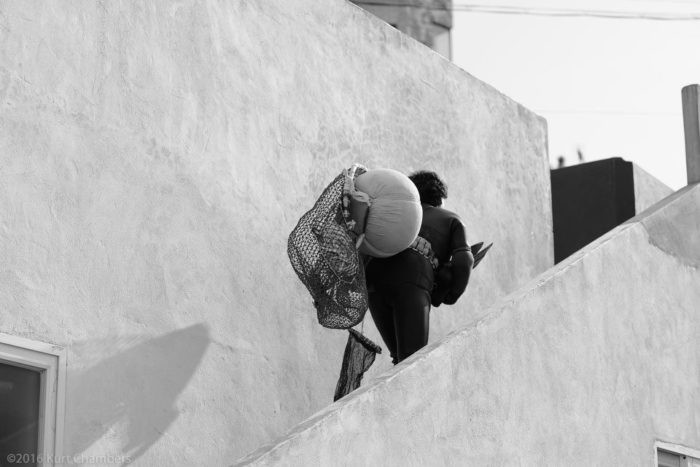
The haenyeo always believe in their own ‘meojeong’—luck or fortune. For example, when a haenyeo descends to sleep she may hope to dream of a bountiful catch the following day, in hope that the sea will listen. And when one manages to procure an abalone, she licks it to show affection in hope of gathering more exactly like it.
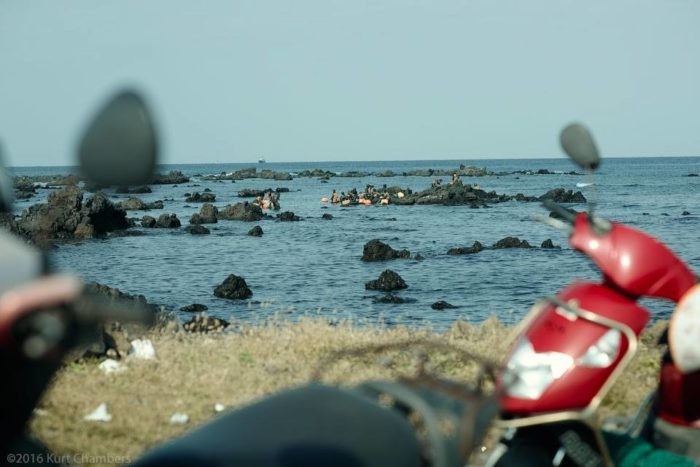
Once the haenyeo began relocating to their selected dive site for the day on bicycles and mopeds, we quickly suited up and followed them.
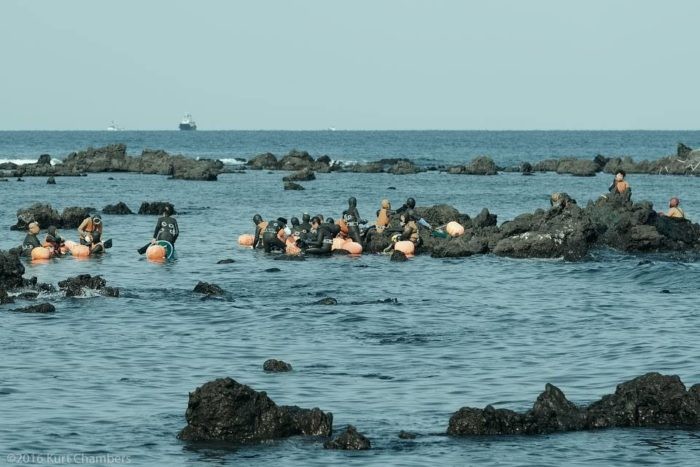
When the haenyeo go into the sea to work it is called ’muljil’, of which there are variations: ‘gotmuljil’ which refers to going out to sea from shore, ‘baetmuljil’ is to go out by boat, and ‘nanbar’.
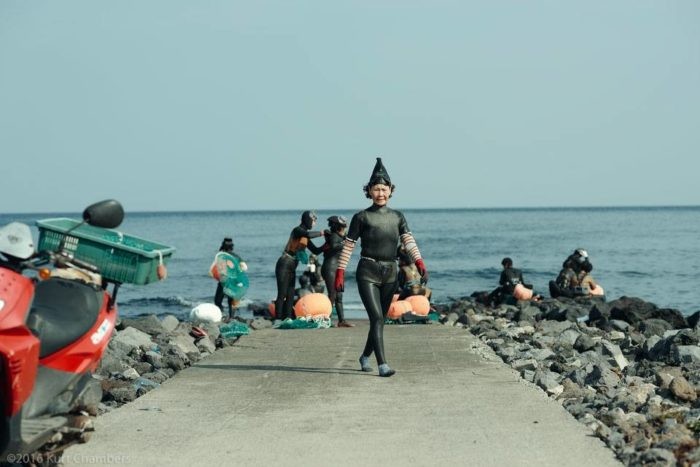
I was grateful for the new 5mm suit I stuffed into my luggage for this single dive of my trip as I slipped into the brisk Yellow Sea for the first time to join the haenyeo. Prior to the introduction of rubber wetsuits to the haenyeo in the 1970s their productivity and time in the water were drastically reduced due to wearing only ‘mul-ot’—water clothes made of cotton. The introduction of wetsuits encouraged them to dive deeper and for longer hours (previously only up to one hour before the necessity of retreat to the warmth of a fire), up to six hours a session, resulting in overharvesting and declining incomes. The haenyeo have been victims of their own hard work ethic.
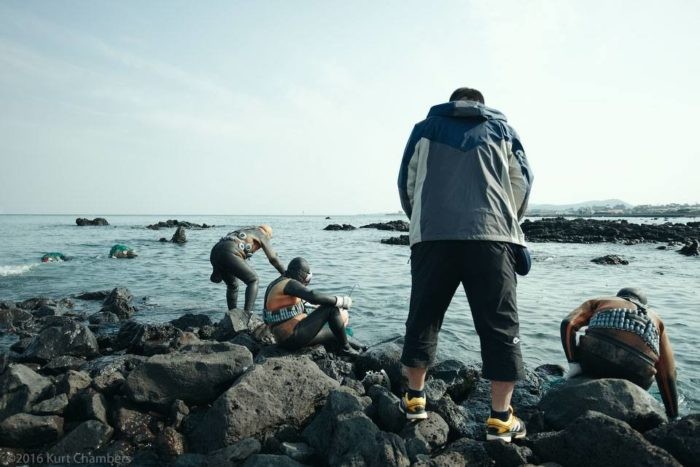
The diving usually begins around 9 in the morning and finishes around 4 or 5 in the afternoon. They go into the sea following the order given by the chief of the fishing troupe.
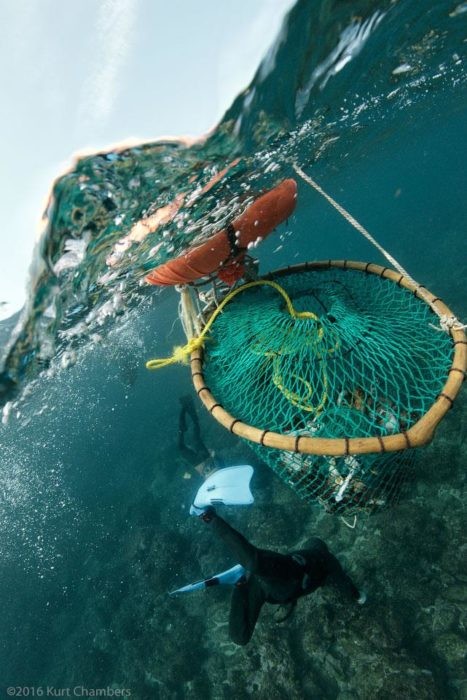
At this particular site the haenyeo were diving only 5 – 8m, and I observed breath-holds mostly around the one minute range. While I’ve heard of much deeper dives and longer bottom times of the haenyeo, any tournament diver knows that if repetition and coverage is the goal, and these haenyeo routinely perform over one hundred dives in a session, short bottom times and constant relocation are more effective.
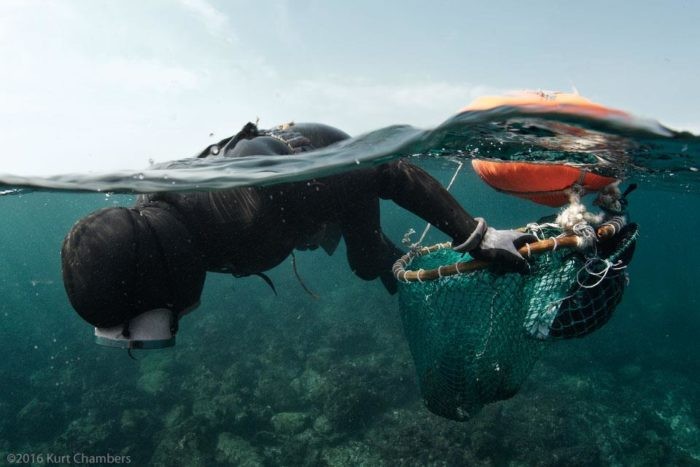
From the surface I could never see the intended catch, but I eventually got the hang of identifying the rocks and crevices with potential.
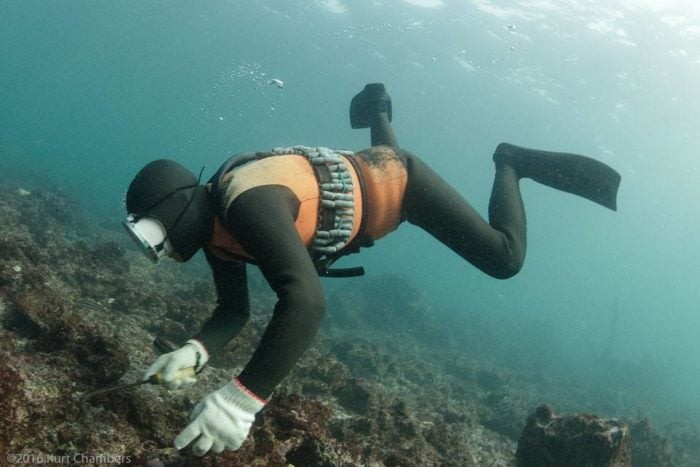
The haenyeo are reputed to know their dive sites as well as the fields they tend when not diving, which they rotate among on a schedule in an effort at conservation.
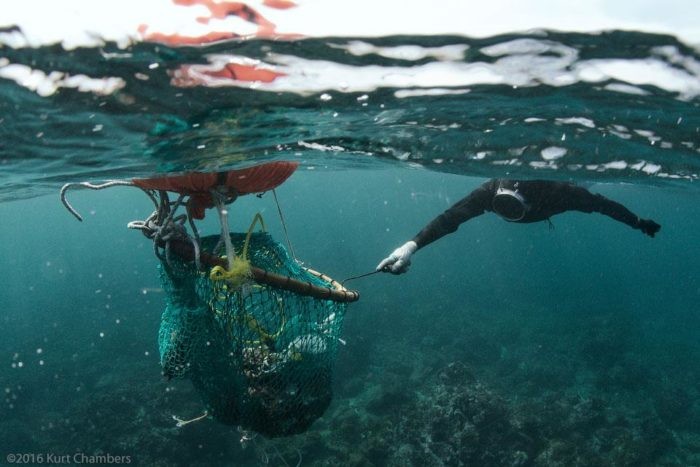
The haenyeo always have with them certain tools: the ‘taewak’ serving as a float, the netted ‘mangsari’ for carrying the catch, the ‘bitchang’ used to pluck abalones loose, and sickle-like ‘homaengie’ for other purposes.
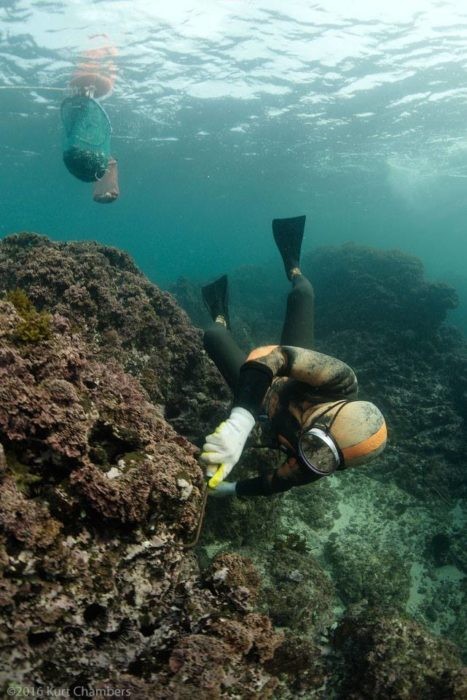
From ‘The Lore of the Jamnyeo’ (1670):
“I would go to the foreshore and place the firewood there and start a fire. I warm my body until it turns red from the heat. I attach the taewak to my chest and tie the mangsari made out of strings to the float. I fill the mangsari with the empty abalone shells that I had caught before. I hold the bitchang in my hand, I swim about here and there and if I feel like it I dive into the water. When I reach the bottom I sweep the rocks over and find out if there are abalones there or not. The abalones that are attached to rocks are so hard and are almost sealed completely by their shells to the rock. This makes it difficult to detach them immediately and the colors are confusing as well as the color of both the rock in abalone shells are black. I place an old empty abalone shell next to it. The shinier inner part of the abalone shell reflects the light brightly on to the spot enabling me to distinguish clearly the abalone from the rocks in the water.”
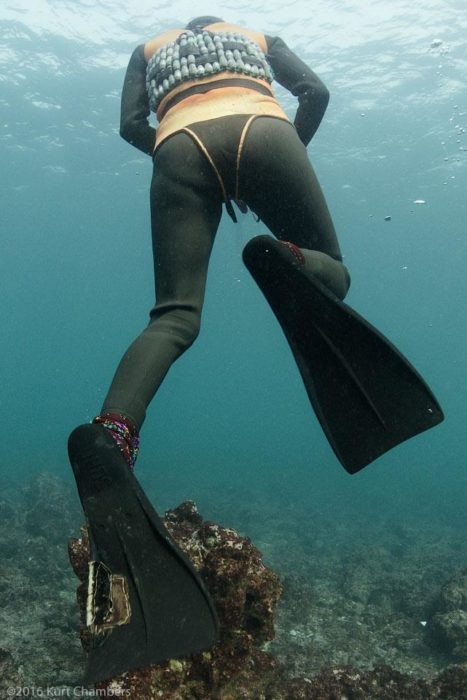
One can’t help but notice how much the haenyeo depended on themselves for developing and maintaining their own equipment. Their home-made weight harnesses particularly demonstrate this; no two haenyeo are fashioned alike.
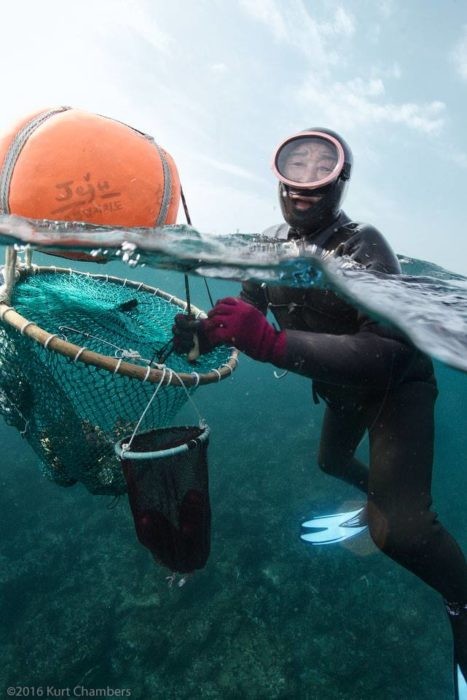
I’m not sure how much or what the women were told of my presence, if anything, but I encountered many different types of reactions as I swam among the 50 or so haenyeo in this troupe, their locations indicated by their floating taewak. Whenever the women smiled or laughed, probably embarrassed at being the focus of my camera, I felt it safe for me to stick around for a few dives.
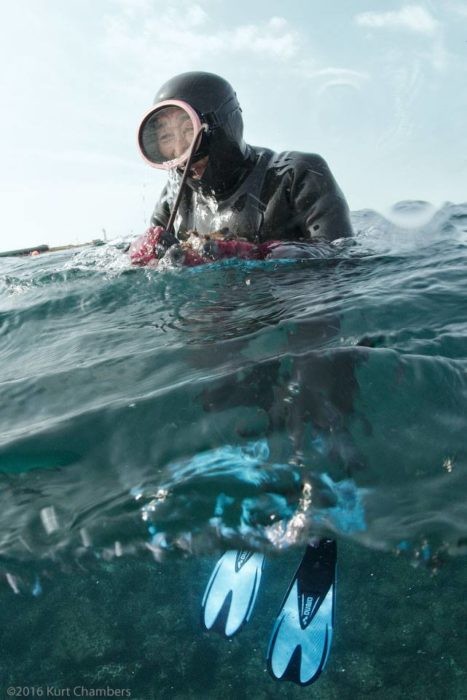
On the other hand, when a haenyeo surfaced and began yelling at me and made me worry about the pointed homaengie she was waving in her hand, I apologized and drifted away quickly (it didn’t help that I don’t speak any Korean beyond a bit of food terminology).
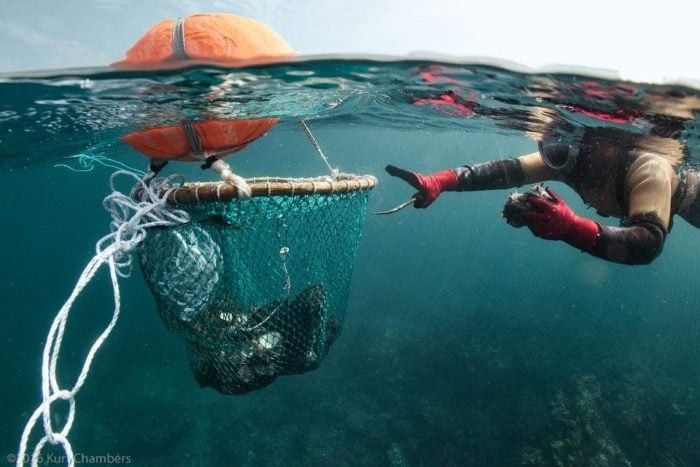
How many divers in Hawai‘i would tolerate being shadowed in the water by some visiting foreign photographer, especially if the session was for income? The haenyeo were probably kinder to me. At least they weren’t targeting elusive fish on this day, instead loading their mangsari with many kilograms of conch.
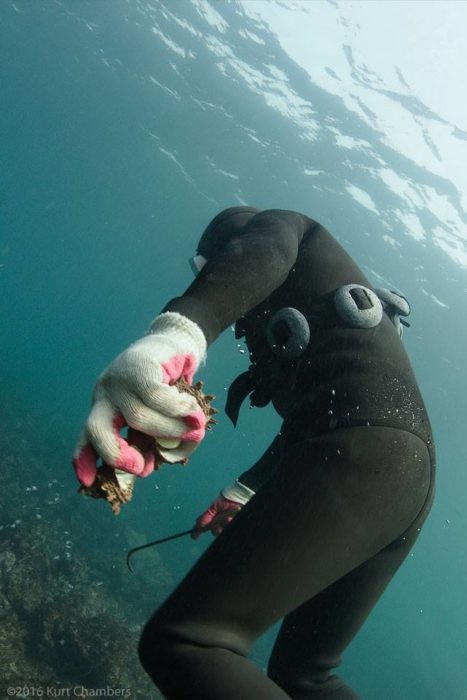
Fish are not commonly sought by the haenyeo (spearfishing is more or less illegal throughout Korea), whose harvests instead primarily contain molluscs such as abalone, conch, octopus, sea urchin, sea cucumber, and various types of seaweed.
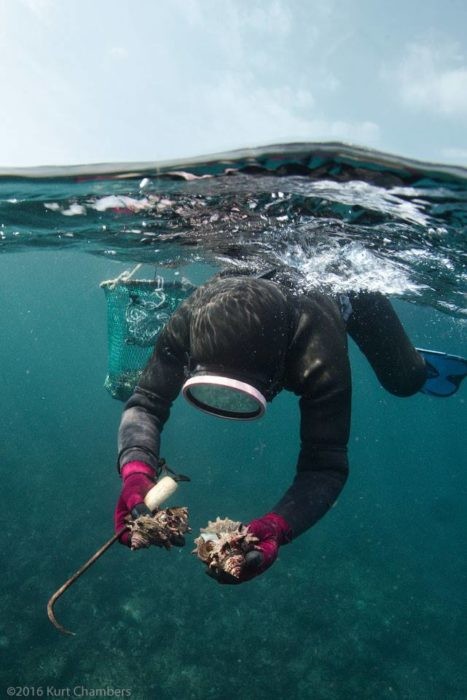
Historically, the haenyeo devised detailed strategies for preserving their livelihood, avoiding harvest during spawning periods, identifying no-diving zones, and having strict regulations as to where haenyeo from specific regions are allowed to dive (reminiscent of the Hawaiian ahupua‘a).
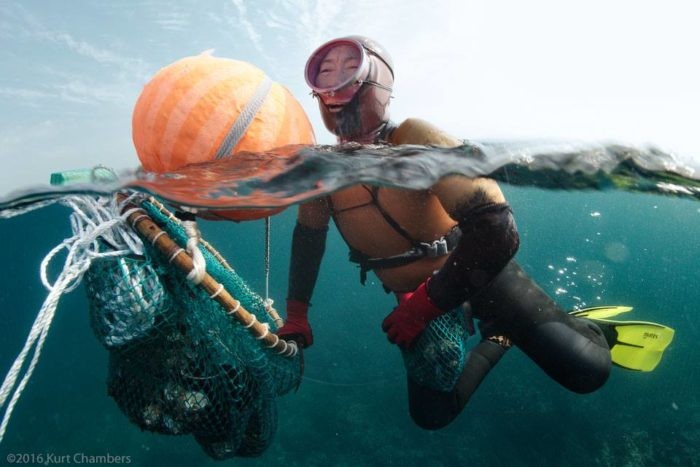
‘Goneum’ refers to a strategy used by haenyeo to discern where they are in the sea by sight, to know the underwater geography as accurately as a map would indicate based on experience in the area and ‘landmarking’—checking location constantly by identifying easily-noticed features on land such as mountains or buildings.
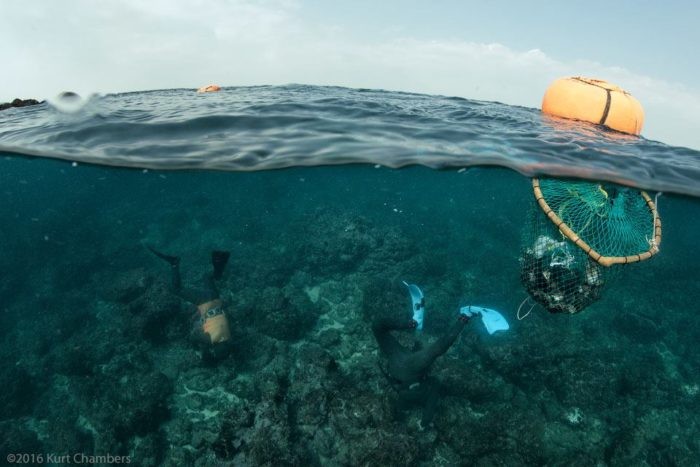
The haenyeo dove in pairs or small groups, and the entire troupe remained within an area of a few hundred meters. Their diving has a strong characteristic of being a group effort, ostensibly for promoting safety.
Within a troupe, the divers adhere to a strict hierarchy: young divers stay clear of the shallow waters where the older and weaker women dive. This hierarchy extended outside the water; there is a tradition of respecting the opinion of older haenyeo, whom are regarded as role models for the entire haenyeo community.
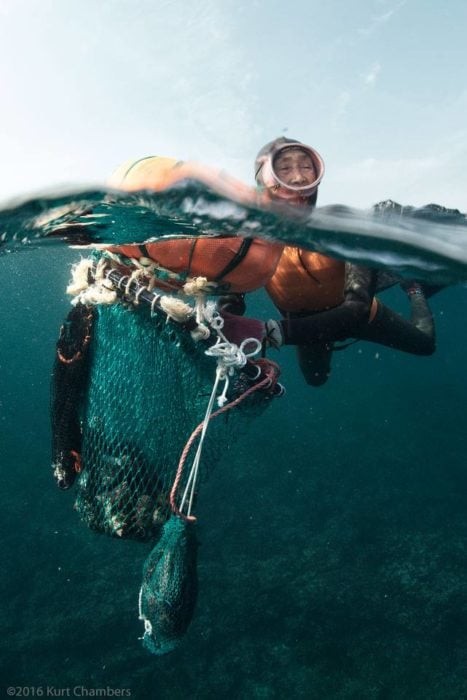
Before long I began to notice a sorrowful whistling sound resonating all around me while I was at the surface. ‘Sumbisori’ is the sound the haenyeos make when they’re at the surface for approximately 1 – 2 minutes between dives, a unique form of recovery breathing believed to purge carbon dioxide and replenish oxygen quickly to minimize surface time.
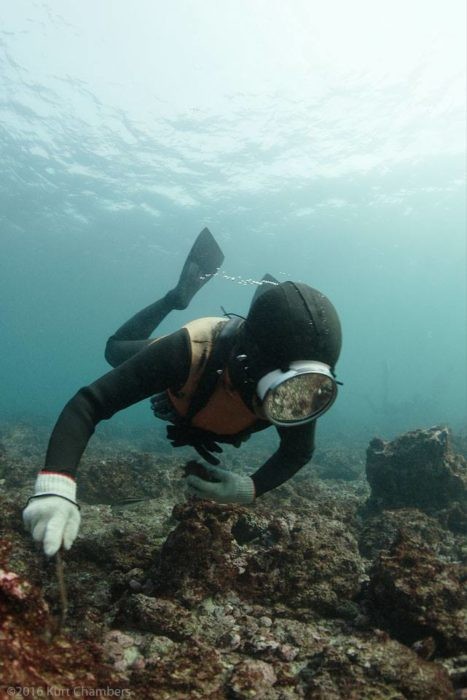
Also mysterious to me is how the haenyeo equalized their ears considering their oval masks had no nose pocket. But the haenyeo are known to suffer ear barotrauma, lose hearing, and have chronic headaches, among difficulties in other areas of the body. Bottles of painkillers and migraine medication are usually strewn about the bulteok.
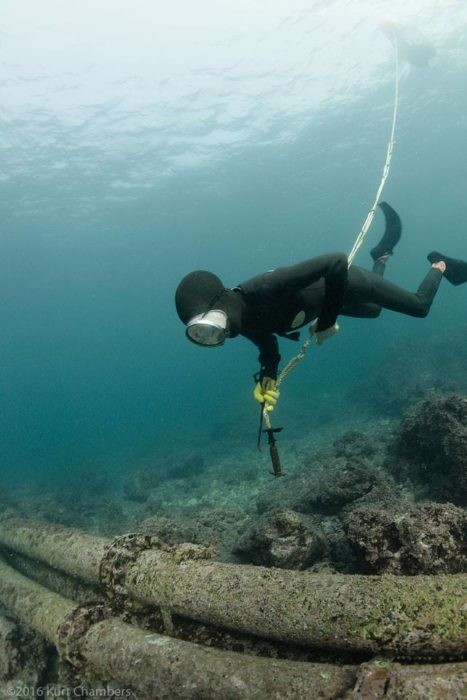
The work is hard and dangerous. Since 2009, 40 divers have died, falling victim to shallow-water blackout, decompression illness and barotraumas, and hypothermia.
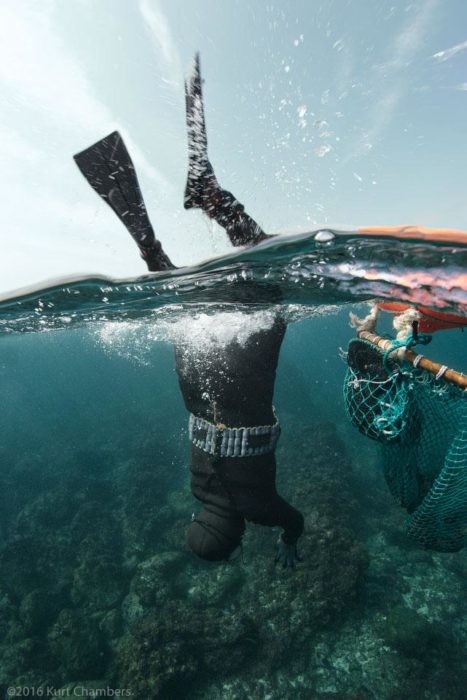
‘We go to the Otherworld below to earn money, and return to this one to save for our kids,’ a haenyeo proverb goes, indicating the sense of reluctant obligation haenyeo have put up with for centuries.
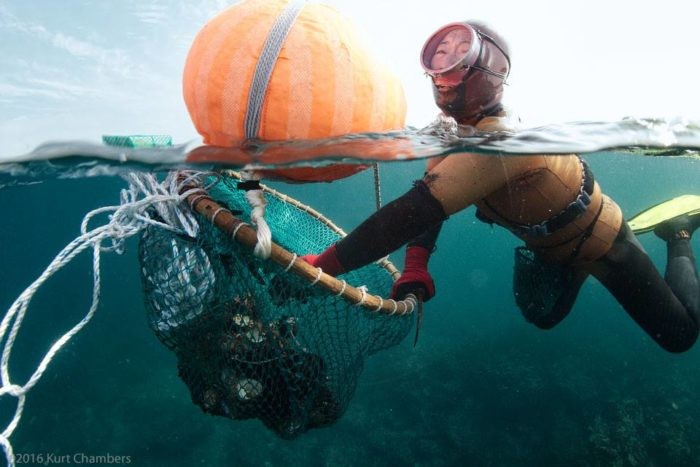
From ‘The Lore of the Jamnyeo’ (1670):
“There were also many instances where I was almost killed trying to get just one abalone. The rocks at the bottom of the sea are razor sharp like a knife and sometimes I see some haenyeos who die because they are stabbed by these rocks. There are even cases where the haenyeos are killed because they are bitten by sea creatures such as water snakes. It is not unusual to see colleagues who die almost instantaneously by freezing to death or having been stabbed by rocks or bitten by sea creatures. I have been one of the fortunate few who have survived all these situations but I am suffering from sickness now. Look carefully at my face if you don’t believe me.”
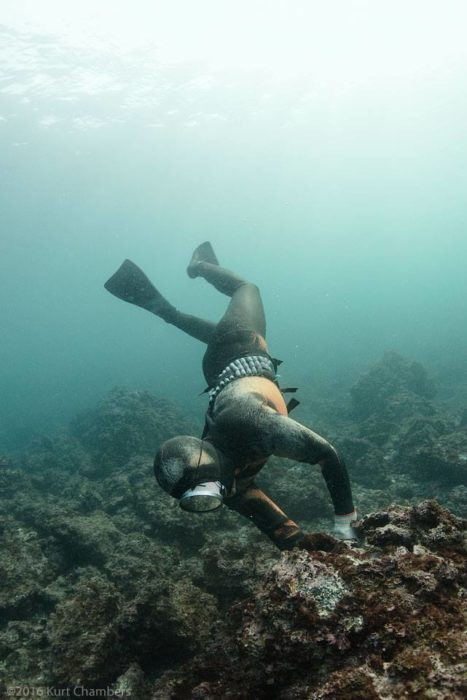
From ‘The Lament of the Jamnyeos’ (1731):
“The haenyeos have been diving and catching the abalone here and there of every sea despite the cold weather. However, they have been doing this so often that the numbers of abalone have decreased and will not meet the quota for the tribute to the king. In such cases, they would be summoned to the administrative office and beaten. In severe cases, their parents were also dragged along with them and put in shackles. Their husbands were also no exception to the beating. Until all the quota that has been assigned to her has been met, they are given no pardon. She drags her suffering body into the sea and in worst cases, she goes through a miscarriage. The saddest part of all this suffering is that her suffering is not only due to the meeting of the quota of the tribute to the king. The abalones were used by the aristocrats and officials as bribes to higher people in power. Even though they try to report this to the king, the route for the message to reach the king is obstructed in manifolds by different hurdles. I myself have been exiled by the king and have been marooned on this island but when I think about the lot of the haenyeos, I cannot take the abalones just for my eating pleasure. From this moment on, do not serve abalones on my dinner table.”
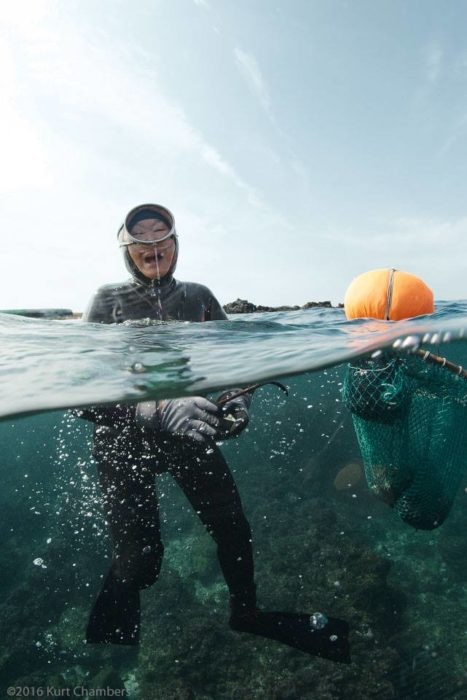
From ‘The Lore of the Jamnyeo’ (1670):
“If my breath runs out at this point I quickly rise up to the surface of the water and breathe in deeply holding on to my taewak. I hear myself breathing out with a ‘whee ~’ sound but I have no idea how long I have breathed out. When I feel better I immediately dive back again into the water. I go back to my marked location, pluck the abalone using a bitchang and put it in my mangsari. I go back to the foreshore but I am feeling so cold that my teeth are chattering and I almost can’t stand the freezing cold even if it is only June.”
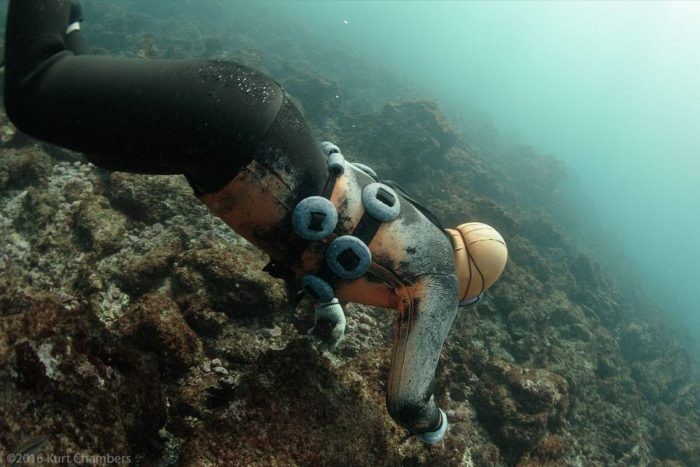
Why continue this dangerous, back-breaking work when alternative opportunities now exist? There were up to 26,000 haenyeos in Jeju until the 1960s but the number has dwindled to under 4,500 now as the popularity of the trade has yielded to modern culture and economic transformation. Jeju was once nothing more than an undesirable outpost for its windy conditions and rough terrain, but the arrival of farm machinery finally allowed cultivation of Jeju’s notoriously rocky soil, today producing Jeju’s prized tangerines. The potential of Jeju’s white beaches, sea cliffs, and snowcapped Mount Hallasan were also eventually realized, as Jeju is now South Korea’s biggest tourist destination. Hence, young women on Jeju would now rather work in resort hotels and car rental offices than dive everyday in miserable conditions.
